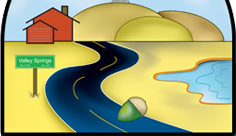


AHWAHNEE WATER PRINCIPLES
& WATER-FRIENDLY SITE DESIGN

Using Water Wisely
How can we ensure that new development minimizes the risks and impacts of stormwater runoff, ground and surface water contamination and flooding? How can we help sustain reliable water supplies and reduce costs?
By growing in a water-wise manner, using water-friendly site design, stretching our water supplies, and implementing wise policies.
The Ahwahnee Water Principles
The Local Government Commission [http://www.lgc.org/] has developed a comprehensive and integrated set of principles and policies (based on whole system planning) called the Ahwahnee Water Principles for Resource Efficient Land Use. These Water Principles offer communities common sense and straightforward ways to address multiple water resource issues with smart planning and land use decisions. Learn more on LGC’s Water Principles page
Look at proposed new development
with an eye to the following principles!!
Ahwahnee Water Principles for Resource Efficient Land Use
Preamble
Cities and counties are facing major challenges with water contamination, storm water runoff, flood damage liability, and concerns about whether there will be enough reliable water for current residents as well as for new development.
These issues impact city and county budgets and taxpayers. Fortunately there are a number of stewardship actions that cities and counties can take that reduce costs and improve the reliability and quality of our water resources.
The Water Principles below complement the Ahwahnee Principles for Resource-Efficient Communities that were developed in 1991. Many cities and counties are already using them to improve the vitality and prosperity of their communities.
Community Principles
The Ahwahnee Water Principles can be grouped into four categories:
I. Growing in a water-wise manner [Principles 1-2]:
Forms that new development should, and should not, take to accommodate population growth and accompanying development and transportation needs without destroying
watersheds – including the natural infrastructure of wetlands, floodplains,recharge zones,riparian areas,open space and native habitats that supply our water.
- Community design should be compact, mixed use, walkable and transit-oriented so that automobile-generated urban runoff pollutants are minimized and the open lands that absorb water are preserved to the maximum extent possible. (See the Ahwahnee Principles for Resource-Efficient Communities)
- Natural resources such as wetlands, flood plains, recharge zones, riparian areas, open space, and native habitats should be identified, preserved and restored as valued assets for flood protection, water quality improvement, groundwater recharge, habitat, and overall long-term water resource sustainability.
II. Water-friendly site design [Principles 3-5]:
Neighborhood and site-scale planning and design strategies that can be used to protect water quality,maximize existing supplies,reduce flood risks,and handle runoff more wisely.
- Water holding areas such as creek beds, recessed athletic fields, ponds, cisterns, and other features that serve to recharge groundwater, reduce runoff, improve water quality and decrease flooding should be incorporated into the urban landscape.
- All aspects of landscaping from the selection of plants to soil preparation and the installation of irrigation systems should be designed to reduce water demand, retain runoff, decrease flooding, and recharge groundwater.
- Permeable surfaces should be used for hardscape. Impervious surfaces such as driveways, streets, and parking lots should be minimized so that land is available to absorb storm water, reduce polluted urban runoff, recharge groundwater and reduce flooding.
III. Stretching our water supplies [Principles 6-9]:
To ensure reliable water supplies in the future, communities need to make the most efficient use of existing supplies. This includes graywater for reuse in the home, office or landscaping, use of water-efficient technologies and designs, and stretching groundwater supplies through treatment and desalinization.
- Dual plumbing that allows graywater from showers, sinks and washers to be reused for landscape irrigation should be included in the infrastructure of new development.
- Community design should maximize the use of recycled water for appropriate applications including outdoor irrigation, toilet flushing, and commercial and industrial processes. Purple pipe should be installed in all new construction and remodeled buildings in anticipation of the future availability of recycled water.
- Urban water conservation technologies such as low-flow toilets, efficient clothes washers, and more efficient water-using industrial equipment should be incorporated in all new construction and retrofitted in remodeled buildings.
- Ground water treatment and brackish water desalination should be pursued when necessary to maximize locally available, drought-proof water supplies.
IV. Implementation Principles:
- Water supply agencies should be consulted early in the land use decision-making process regarding technology, demographics and growth projections.
- City and county officials, the watershed council, LAFCO, special districts and other stakeholders sharing watersheds should collaborate to take advantage of the benefits and synergies of water resource planning at a watershed level.
- The best, multi-benefit and integrated strategies and projects should be identified and implemented before less integrated proposals, unless urgency demands otherwise.
- From start to finish, projects and programs should involve the public, build relationships, and increase the sharing of and access to information.
- Plans, programs, projects and policies should be monitored and evaluated to determine if the expected results are achieved and to improve future practices.
Authors: Celeste Cantu, Martha Davis, Jennifer Hosterman, Susan Lien Longville, Jeff Loux, John Lowrie, Jonas Minton, Mary Nichols, Virginia Porter, Al Wanger, Robert Wilkinson, Kevin Wolf
Editor: Judy Corbett
(Adopted in 2005)






